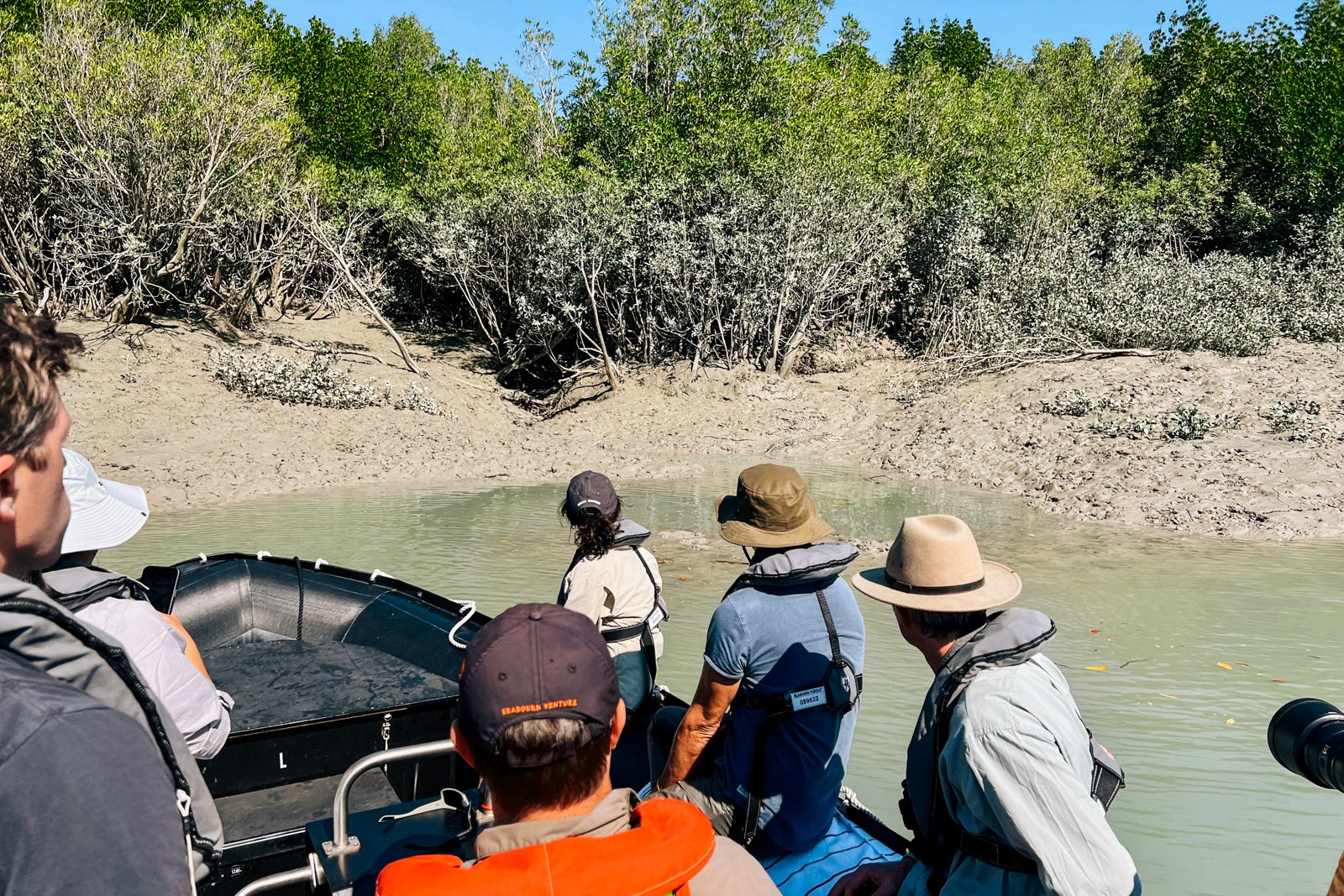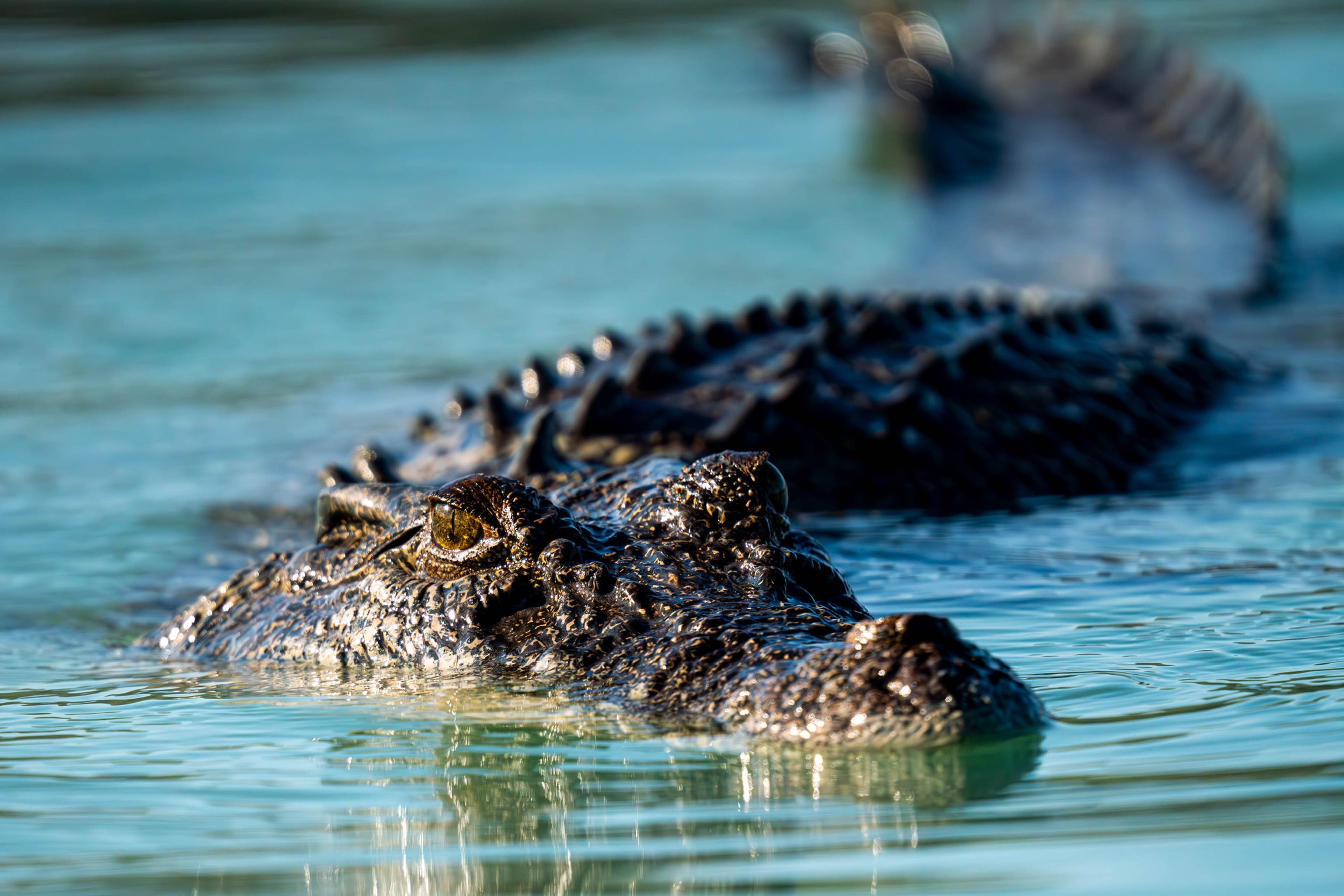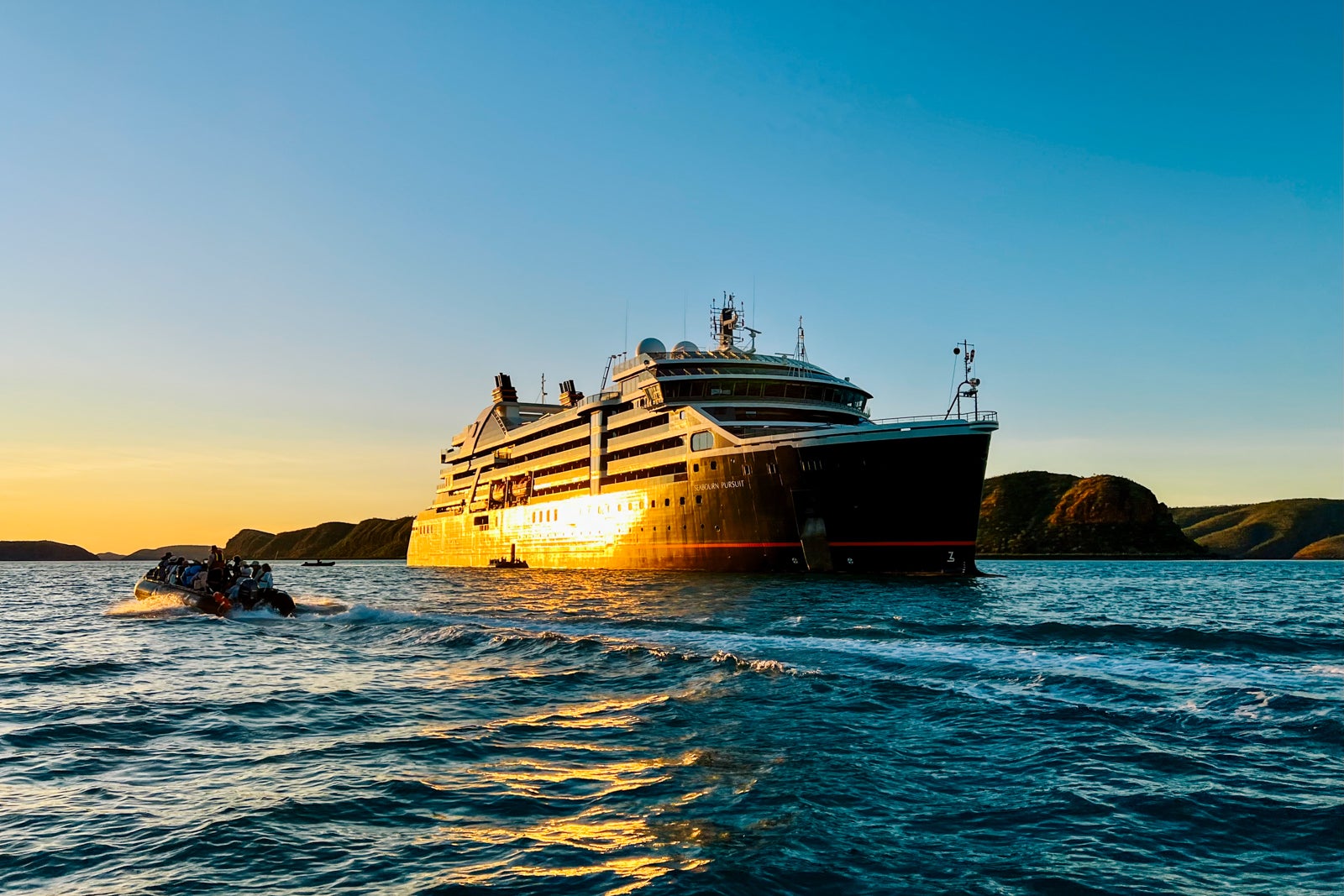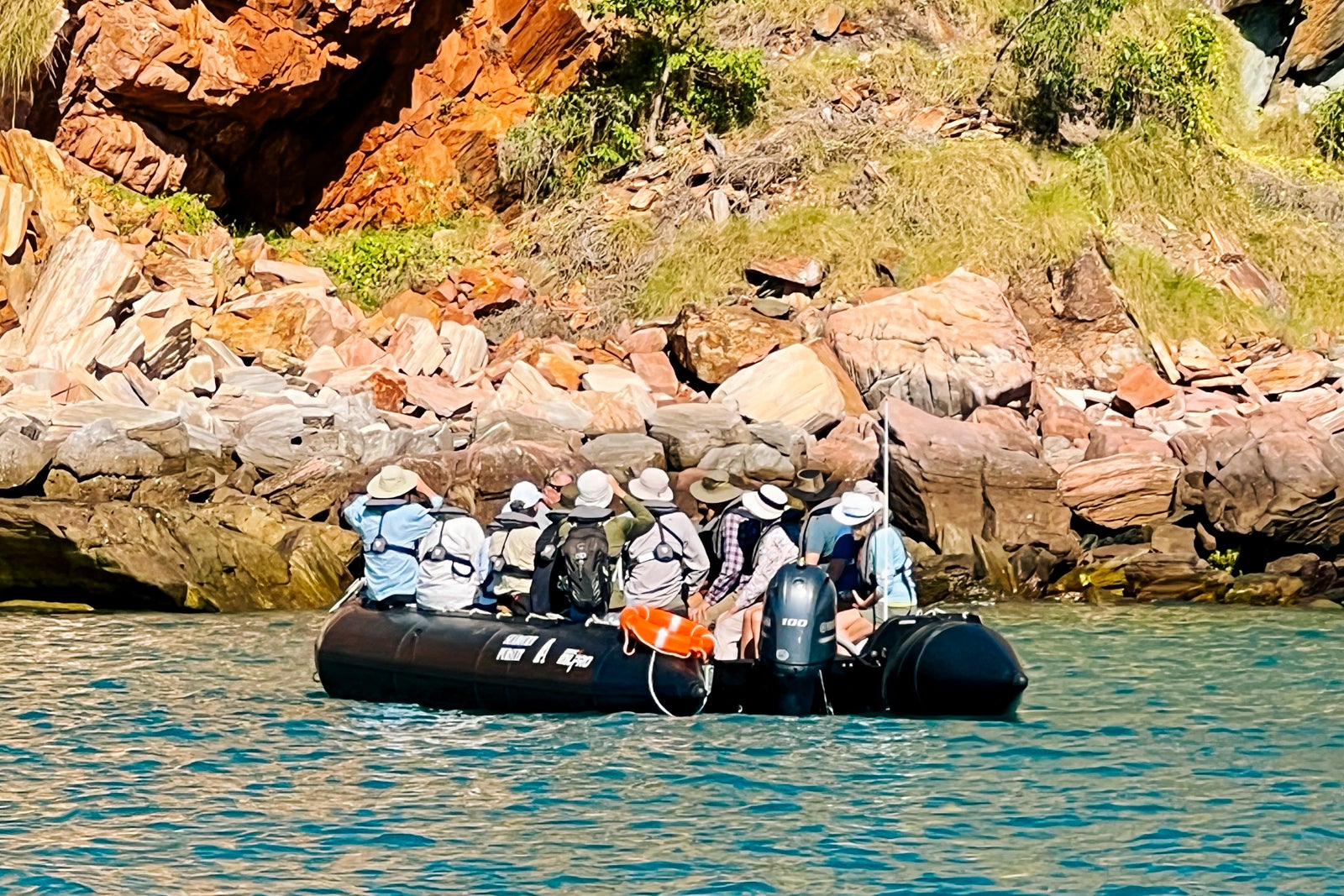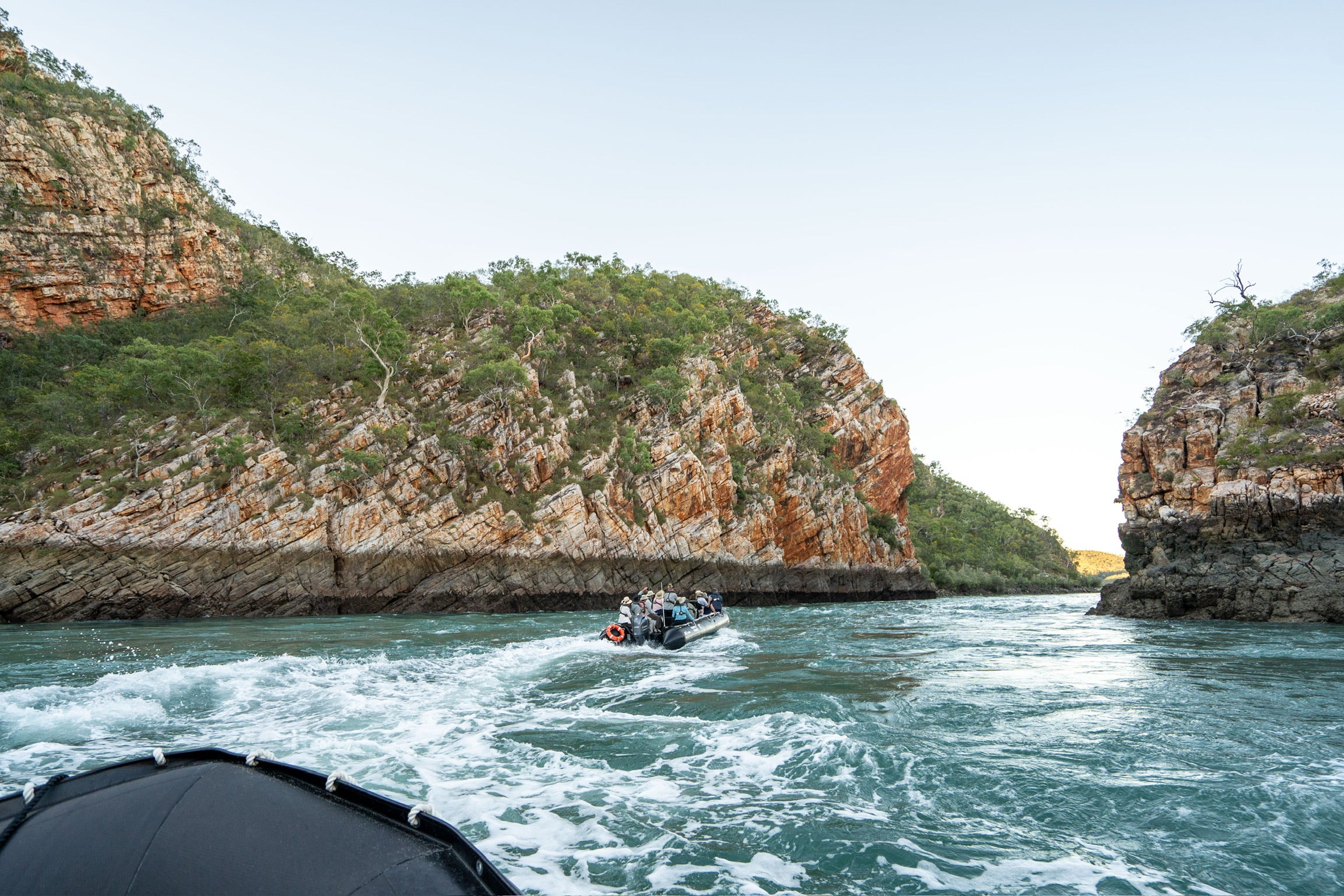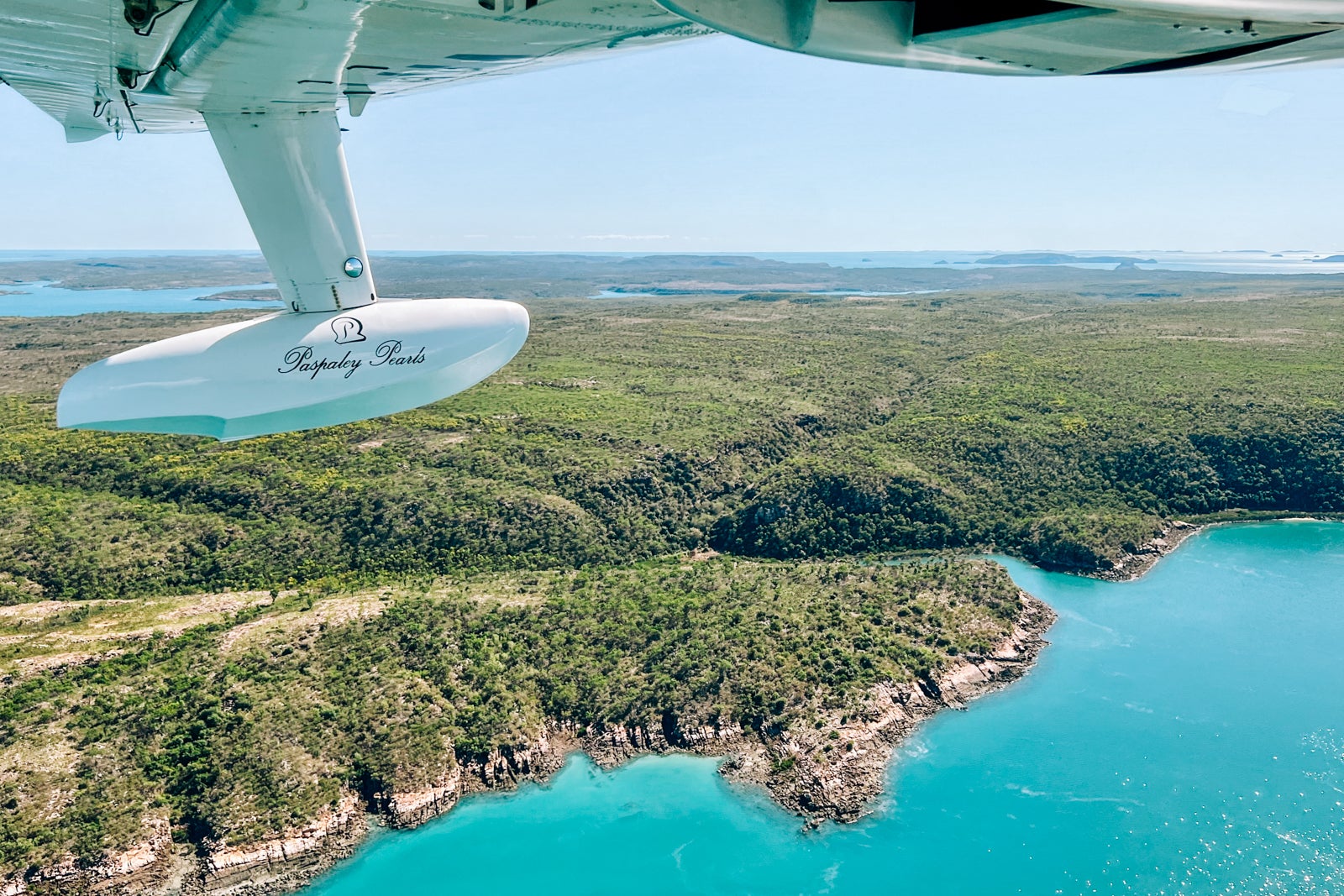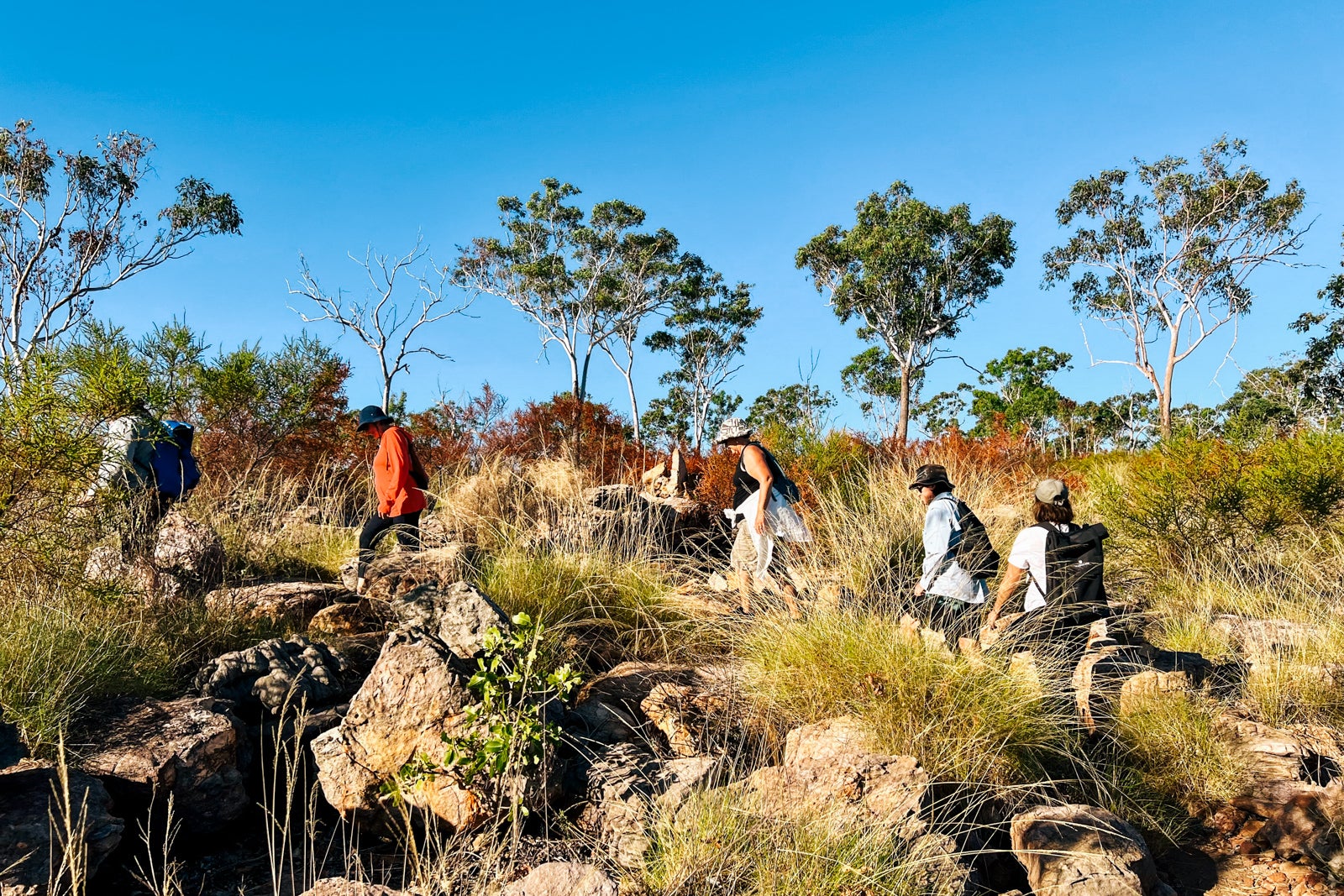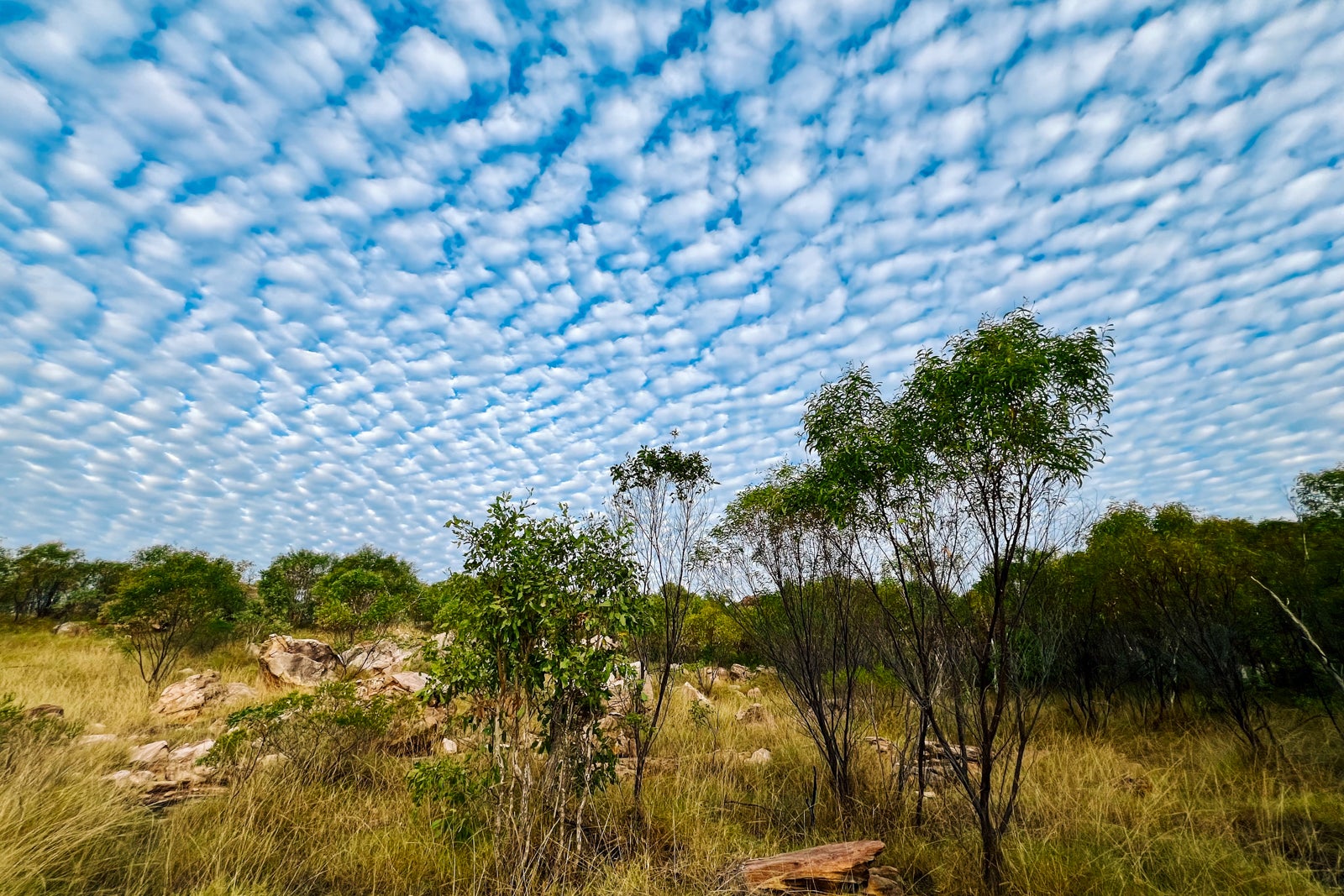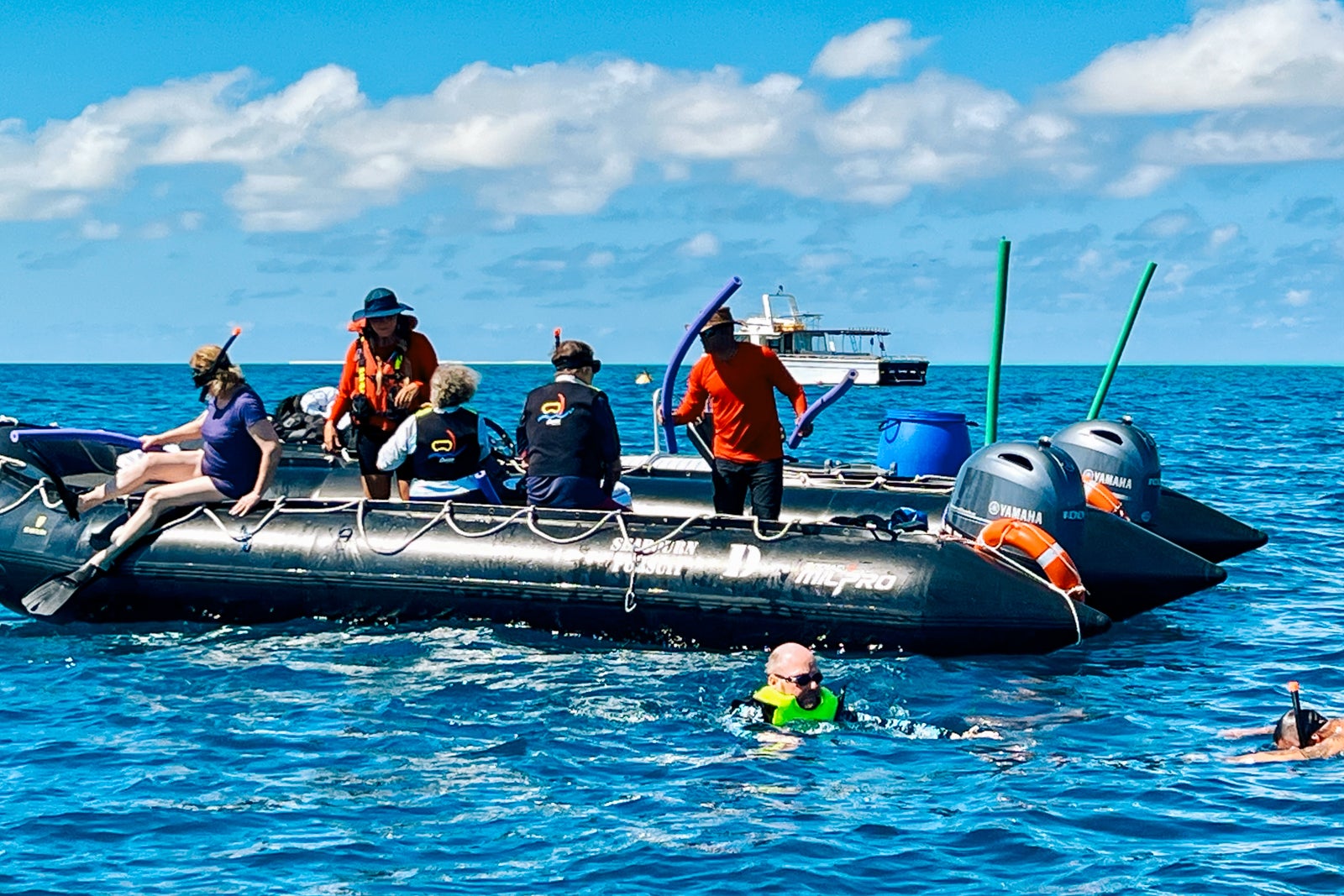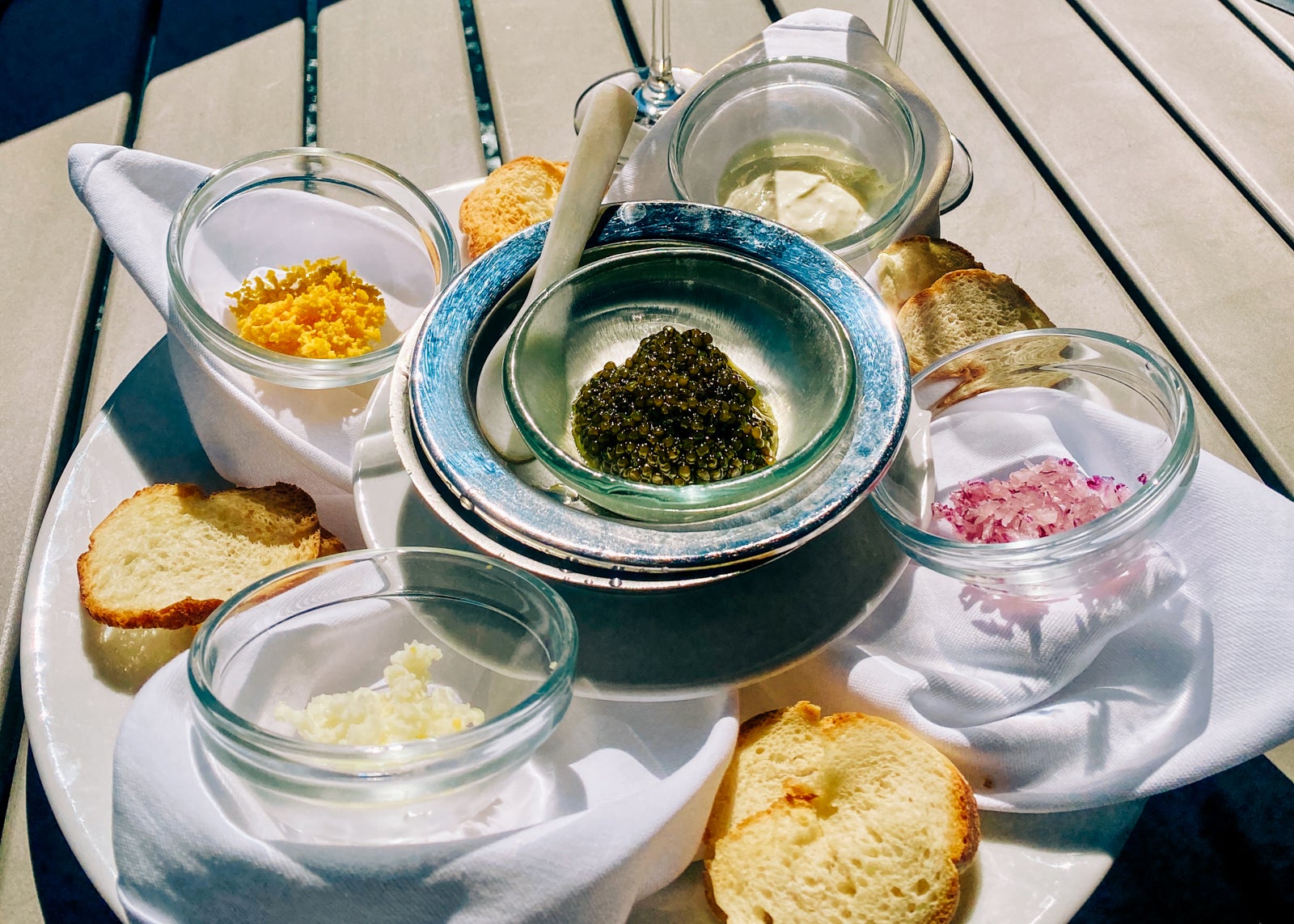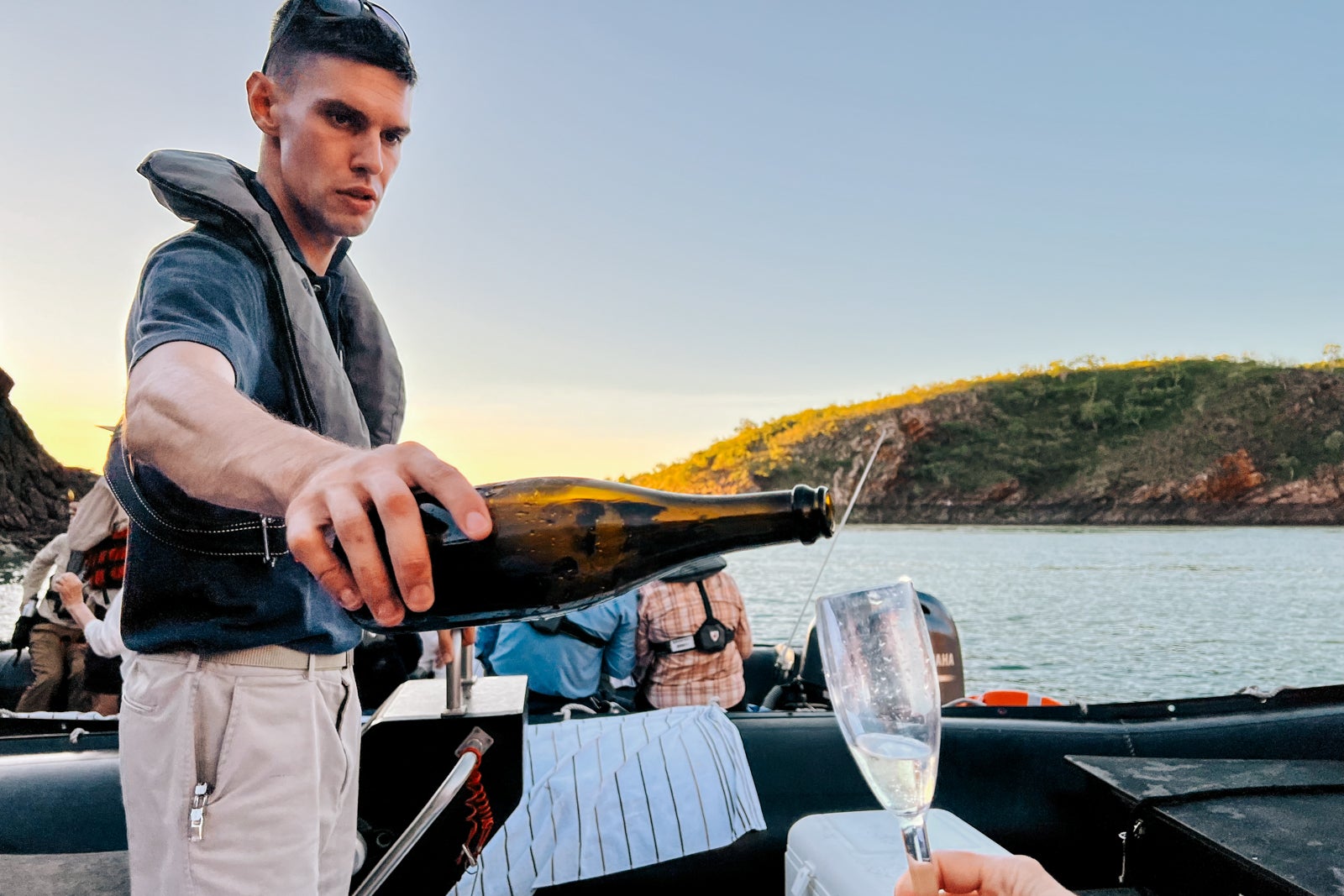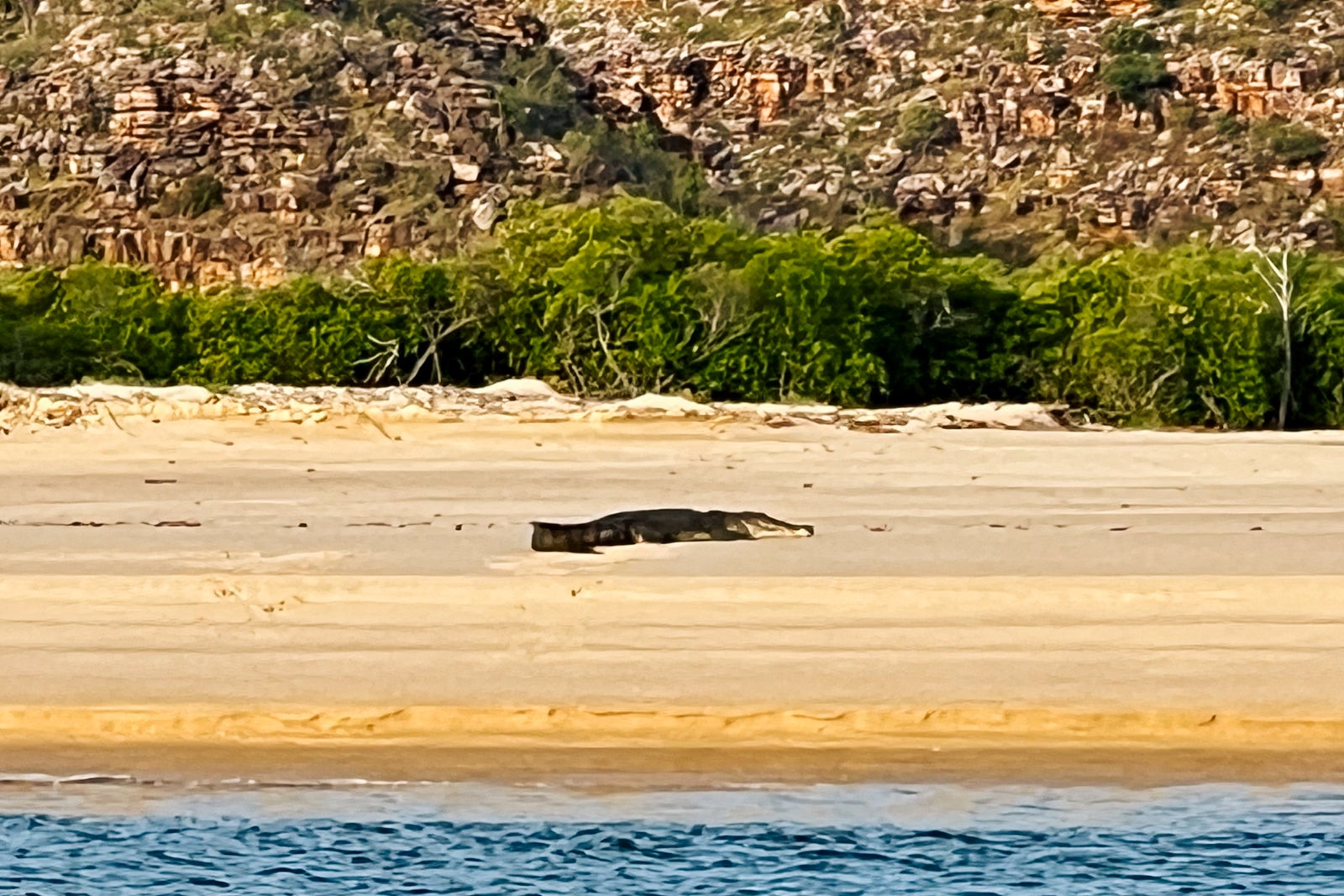My traveling companions, I am convinced, have lost their minds.
They are telling me there is a massive saltwater crocodile lounging along the muddy river bank just a few dozen feet from our Zodiac boat. But all I can see is mud.
Even when they point right at it, I miss it.
Until I don’t.
It is the eye that gives it away. A big yellow eye. Watching us.
Once I see it, the rest comes into focus. The spiky back, covered in a film of mud that makes it almost undetectable. The tail, partly submerged in the river. The giant jaw, locked in a smile — or is it a smirk?
For more cruise news, guides and tips, sign up for TPG’s cruise newsletter.
I’ve been told we’re perfectly safe in the Zodiac boat. But still, I shudder. This crocodile, like all crocodiles in this remote corner of Australia we are exploring, the Kimberley region, is terrifying in its enormity. Menacing. It wants to eat me. I’m sure of it.
I recall how one of our expedition guides described the giant creatures before we set off from our luxurious expedition ship, Seabourn Pursuit, in search of them.

Daily Newsletter
Reward your inbox with the TPG Daily newsletter
Join over 700,000 readers for breaking news, in-depth guides and exclusive deals from TPG’s experts
The “perfect … killing … machine.”
He said it just like that. Three words, spaced apart as if separate sentences. For emphasis.
That was after he cheerfully noted that crocodiles leave no bubble trail as they sneak up on you underwater and that they leave no wake on the surface. One moment, they’re just there. The next moment, you’re not.
His advice: Keep your arms and hands in the boat at all times.
After coming eye to eye with one of them up close, I won’t need to be told again.
It is just one of many lessons I absorb as I travel the Kimberley coast on Seabourn Pursuit — the newest, biggest and most luxurious expedition cruise ship to call the region home. The 264-passenger vessel, which just launched in August, is like a floating classroom for learning about the wildlife, scenery and history of this famously rugged landscape.
A rare adventure
Our search for saltwater crocodiles, known to scientists as Crocodylus porosus, takes place as we explore a backwater of the Kimberley called Porosus Creek — the matching names not being a coincidence. The mangrove-lined tributary of the Kimberley’s Hunter River teems with them.
Like all of the Kimberley, it’s a primordial setting. In addition to gigantic crocodiles (some more than 20 feet long), its muddy banks are covered with small pincer-wielding crabs and fabulously bizarre-looking mudskippers — a type of amphibious fish — that are hopping every which way. Tangles of mangrove roots form impenetrable barriers. Giant ocher cliffs serve as a backdrop.
It’s the sort of tableau where you expect dinosaurs to come crashing into the frame at any moment.
Maybe they will. Judging from what I’ve experienced on this 10-night adventure along the Kimberley coast, anything is possible.
Still uncharted in some areas, the Kimberley is a relatively little-visited, hard-to-reach corner of the planet that’s home to such natural wonders as “horizontal waterfalls” and a massive reef that seemingly rises like magic from the sea.
It’s also a place that is suddenly on all the lists of hot spots for international travel.
Until recently, despite its allures, it was a destination you could only get to by way of a small expedition ship operated by one of several small Australian expedition cruise companies. True North and Coral Expeditions, which catered mostly to adventurous Australians and were almost unknown in the rest of the world, were the two main players.
But a wave of internationally known cruise brands that operate expedition cruise ships — a type of cruise ship specifically designed for off-the-beaten-path travel — have been adding the Kimberley to their schedules, putting it on the international tourism map. Luxury cruise company Seabourn, which operates Seabourn Pursuit, just started Kimberley trips this summer, as did Scenic Luxury Cruises & Tours. Upscale line Ponant has a new ship in the Kimberley this summer, too.
Two other international brands, Silversea Cruises and Lindblad Expeditions, have operated in the Kimberley a bit longer but are still relatively new to the region. In Lindblad’s case, the line just resumed Kimberley trips in 2023 after an eight-year absence.
Of all of them, Seabourn is getting the most attention of late, no doubt because of Seabourn Pursuit’s size and luxury. It’s the swankiest way you can explore the Kimberley yet.
Seabourn is also offering trips to the region crafted with the involvement of Indigenous Australian people with ties to the area — something that hasn’t been done before.
In short, Seabourn Pursuit is at the vanguard of a new era of tourism in the region.
The journey east
To venture into the Kimberley, whether by luxury expedition ship or more basic transport, is to go back in time. It is to leave civilization behind in favor of a “The Flintstones”-like prehistoric land.
Our Seabourn Pursuit sailing along the Kimberley coast begins in Broome, the only settlement of any size in the region — and the last place where we find much more than the wild lands that the Australians call “bush.”
Located on the western end of the Kimberley, the small town of 15,000 people serves as a gateway of sorts for tourism to the area, thanks to its small airport. But it’s not a tourist town as you might imagine. Its “downtown” is just a couple of streets of eateries, bars and shops. It offers just a handful of hotels where you can spend the night before heading off on an adventure.
On our trip, many passengers do just that. Or, they’ll spend a few nights to allow time for a flightseeing tour to the striking sandstone domes of the nearby Bungle Bungle Range or a sunset camel ride along the endless white sands of Broome’s Cable Beach.
It is a first taste of the stunning landscape of the Kimberley region, where we will spend the next 10 days.
The Kimberley is an enormous place — including its inland areas, roughly three times the size of England. But it’s still mostly devoid of people — it’s home to maybe 40,000 inhabitants — and not easy to tour. Large swaths of its coastal areas are a wilderness that’s only accessible by boat or floatplane. Hence the growth of expedition cruising to the area.
Boarding Seabourn Pursuit from a lonely jetty several miles from Broome’s center, we soon are steaming into the heart of it.
As we learn during our first outing from the ship, a Zodiac ride through the narrow waterways of the Buccaneer Archipelago, it is a land of dramatic red rock cliffs, gorgeous bays, mangrove-lined rivers and a wide range of wildlife.
It’s also a land of massive tides — some of the biggest in the world. Water levels can rise or fall more than 40 feet in some places every few hours. It’s one of the defining factors of the landscape.
Zipping around Hidden Island (so called because early explorers mapping the coast somehow missed it), we see the power of the tides at Whirlpool Pass, a narrow waterway that churns from the rapid movement of water.
Still, it isn’t until our second day of exploring, farther east at Talbot Bay, that we get a true sense of the intensity of the tides. It is here that we come face-to-face with the first of several world-renowned marvels of the Kimberley: the twin “horizontal falls.”
Despite the name, they aren’t waterfalls at all, but 30-foot tides gushing through gorges so narrow they create temporary cascading rapids every few hours — first one way, then the other. As the water rises and falls, the flow can reach an astonishing 30 knots. At its peak, the “waterfall” of the tides cascading through the gorges can be more than 10 feet in height — an astonishing sight.
Until recently, many tour companies bringing visitors to the horizontal falls took them through in small boats. But on our visit, we only go close to the falls on Zodiac boats, not through them, in deference to the wishes of the Traditional Owners of the area, the Dambimangari.
Traditional Owners is the term used in Australia to denote Indigenous individuals or groups who have a traditional connection to an area of land.
The horizontal falls site has important cultural significance to the Dambimangari, who have asked that such trips through the falls be stopped.
Still, even at the edges of the falls, we feel their power. Our Zodiac fishtails atop the rushing water, sending us grabbing for the safety ropes along the boat’s edge.
A natural wonder
The Kimberley may be home to miles of wilderness, but it’s not entirely devoid of human activity — something we learn the next day as Seabourn Pursuit drops anchor in remote Kuri Bay.
Only accessible by boat or floatplane, it’s the site of a pearl farming operation that dates to 1956 — the oldest in Australia.
Landing by Zodiac at a small dock, we tour a small cluster of buildings where several dozen workers live for weeks at a time as they tend to thousands of seeded pearl oysters spread across the surrounding waters. Paspaley Pearling Company runs the site and is known for some of the world’s finest pearls.
1 of 5
Seabourn Pursuit passengers arrive at the Kuri Bay pearling station by Zodiac. GENE SLOAN/THE POINTS GUY
Long before it became known as an off-the-beaten-path tourist destination, the Kimberley was known for pearls. Indeed, our starting point for the trip, Broome, owes its existence to a gold rush-like boom in pearling along the coast in the 19th century. At its height, more than 400 pearling boats, known locally as luggers, called it home.
The Kuri Bay tour is a crash course in modern-day pearling, which is more complex than I had imagined. For instance, I learned the wild pearl oysters that thrive in this area are manually seeded, one by one, with tiny polished spheres of Mississippi clamshell — apparently just the right little nugget to get them to form the perfect pearl.
It just may be the least known tie between America and Australia.
Still, the highlight of our Kuri Bay visit is the chance to see the Kimberley from the air. Paspaley offers short 20-minute rides over the surrounding area in a vintage 1940s-era Mallard floatplane it uses for supply runs.
From the air on one of these rides, I marvel at the curving lines of pearling cages submerged in the pristine waters around the camp. I also get a new perspective of the Kimberley’s endless expanse. Rocky scrubland stretches inland for miles from the water’s edge.
The next day brings a landscape so different that we might as well have been transported to the moon.
One of our expedition guides whispers us awake at sunrise over the public address system as the ship anchors nearly a dozen miles from the coastline. We are about to witness another of the Kimberley’s natural wonders: land rising from the water.
Or so it seems. As our guides explain to us, it isn’t land at all but Montgomery Reef, a massive marine ecosystem that seemingly rises from the ocean every few hours due to the huge Kimberley tides.
1 of 6
GENE SLOAN/THE POINTS GUY
Racing out to it in Zodiacs, we marvel as millions of gallons of water cascade from the emerging reef in bubbling rivers, revealing a lava field-like landscape of crevices and pools where trapped fish and other marine creatures become a feast for awaiting egrets. We spot dolphins and a green sea turtle arriving for the buffet. Reef sharks, manta rays and dugongs (marine mammals that resemble manatees) are also in the area.
As we learn during an onboard lecture, it is the world’s largest — and perhaps most unusual — inshore reef. Because the giant tidal drop of the area leaves it exposed to the air and sun for several hours each day, some of its corals have adapted to secrete a mucuslike substance that keeps them from drying out and burning in the sun. Call it natural sunscreen.
Rock art and an island paradise
While the first few days of our trip are all about the Kimberley’s striking landscape, the next few days shift focus to the Indigenous people who have called the region home for tens of thousands of years. They are punctuated with two epic wildlife experiences: the day exploring for crocodiles in Pororus Creek and a snorkeling outing along a pristine reef.
Our introduction to the Indigenous people of the area begins just hours after our visit to Montgomery Reef when we land by Zodiac at Freshwater Cove for a hike. Our guide from the ship walks us inland through spikey acacia shrubs and rough-barked corymbia trees to a cave with thousands-year-old rock art.
Waiting there is a member of the Indigenous Worrorra people who have traditional ties to the area. He points out images of fish, stingrays, turtles and other wildlife on the ceiling of the cave, as well as a weblike image meant to mimic a cyclone. They are painted with naturally made ocher pigments that have survived thousands of years. (Out of deference to the wishes of the land’s Traditional Owners, I am not showing pictures of the art at the Freshwater Cove site.)
The art, protected from the elements by an overhang, is from the Wandjina period, which dates to around 4,000 years ago or more. We are told it’s just one of hundreds of such sites in the area.
Several days later, at Ngula (Jar Island), we see rock art that is many times older — perhaps tens of thousands of years old. Found in cavelike spaces in rocky outcroppings, the Gwion Gwion art, as it’s known, is strikingly different from the Wandjina paintings. It includes finely drawn images of thin human figures ornamented with tassels, bags and headdresses.
These latter images and others like them across the region are notably the oldest detailed depictions of human figures in the world.
1 of 5
GENE SLOAN/THE POINTS GUY
The stop at the site has a backstory. Seabourn has spent several years developing a relationship with the Wunambal Gaambera people, the Traditional Owners of the part of the Kimberley that encompasses Ngula, which is unusual in the history of Kimberley tourism. It includes helping to fund a Wunambal Gaambera project to build infrastructure to support visits to the site on their own terms.
As part of the relationship, Wunambal Gaambera representatives are welcoming Seabourn passengers to the island with a traditional Welcome to Country smoke ceremony, something I experienced firsthand during my visit.
Additionally, Seabourn Pursuit is sailing with two Traditional Owners from the Kimberley region. They serve as Indigenous guides, sharing their experiences and those of their people.
Such interactions with Traditional Owners are something that has been mostly missing in the Kimberley experience until now.
Our days exploring the rock art at Freshwater Cove and Ngula bookend our crocodile experience at Porosus Creek, with one more day wedged in for our only excursion away from the Kimberley coast: a trip to Ashmore Reef.
Nearly 200 miles off the Kimberley coast in the Indian Ocean, Ashmore Reef is a far-from-anywhere grouping of three sandy islets surrounded by one of the most beautiful coral reefs in the world.
While the visit to Ashmore Reef is mostly a “technical stop” to keep Seabourn Pursuit in compliance with local law (as a non-Australian ship, it must make an offshore call to be able to sail the Kimberley coast), it also offers the chance for a spectacular if short snorkel along the reef.
Among the highlights for me was seeing giant clams and the striking bluish-purple sea stars — like no sea stars I had seen before — that call the reef home. The diversity of the coral, which came in all shapes, sizes and colors, was a treat. So was the abundance of reef fish.
Luxury in the Kimberley
There may be little infrastructure for tourism along the Kimberley coast, but that doesn’t mean we are roughing it. As we move from bay to bay to explore by Zodiac and on foot, we are doing it in the utmost style.
Unlike many of the other expedition vessels that bring visitors to this region, Seabourn Pursuit has all the elements of the most elegant and upscale hotels on land, including spacious suites, multiple stylish lounges, fine dining and a full-service spa.
This is, in part, because of the ship’s size, which is several times larger than some of the very small vessels that have brought visitors to the area for years, such as True North’s 36-passenger True North and 20-passenger True North II.
Even compared to some of the newer, bigger vessels that other international brands are bringing to the area, Seabourn Pursuit is larger and has more venues. It’s more than twice the size of Ponant’s 184-passenger Le Jacques-Cartier, which also is sailing in the Kimberley this year for the first time, for instance.
1 of 5
Seabourn Pursuit is a luxury ship with elegant outdoor lounge spaces. GENE SLOAN/THE POINTS GUY
Seabourn Pursuit’s bigger size allows for not just more upscale venues on board but also a bigger staff. It typically sails with 238 crew members, nearly one for every passenger. That’s an unusually large ratio. As a result, it’s a ship that, in theory, should operate with the highest level of service (though I found the service hit-or-miss at times).
Among the luxury touches on our sailing are free-flowing Champagne and caviar — you can order it to wherever you are on the ship at any time, no extra charge — and multicourse meals served in a formal sit-down dining room.
During outings by Zodiac, passengers are often surprised by the dining staff in separate Zodiacs delivering Champagne or cooling ice pops right to their boats. On our way back from our morning trip to Montgomery Reef, we landed on a sandbar where awaiting staff members surprised passengers with bloody marys and Champagne.
It is, for sure, the new luxury way to do the Kimberley — if you have money to burn.
As you might expect for such a high-end vessel, Seabourn Pursuit has a price point that might shock some. Suites on the vessel — and every cabin is a suite — often start at around $2,000 per day.
The least expensive Kimberley coast departures on the vessel start at $8,499 per person, based on double occupancy. (That is, it’ll cost you $16,998 or more per couple for a cabin.)
Such a princely sum, to be fair, is not all that unusual for an expedition cruise to the Kimberley. Voyages operated by Silversea, Ponant and Scenic in the region start at around the same price point.
One last crocodile
That expedition cruise companies would send vessels to the Kimberley in ever greater numbers was perhaps inevitable.
For many years, expedition cruising was primarily about exploring what long were the two biggest and most alluring blank spots on the planet: Antarctica and the Arctic. It was about travel to remote polar regions that most people never got to see.
But as expedition cruising has grown in popularity, expedition cruise companies have needed to find new remote and awe-inspiring places to take their customers. Of all the remaining off-the-beaten-path corners of the world reachable by ship, there are few as filled with natural wonders and unusual wildlife as the Kimberley.
1 of 5
A visit to the Kimberley’s King George Falls is the highlight of the final outing of the trip. GENE SLOAN/THE POINTS GUY
I was thinking about this on our last outing from Seabourn Pursuit, a Zodiac ride up the stunning King George River. The landscape was epic on a scale of what you see in Antarctica, with river banks lined with soaring red rock cliffs that got taller and taller as we headed inland. Eventually, the path up the river dead-ended at King George Falls, a world-renowned cluster of waterfalls that plunges hundreds of feet over ancient sandstone cliffs.
As I sat in the Zodiac, looking up at this natural marvel, I thought about how wild this land remains, how spectacular it is, and how untouched it is by modern humans’ development.
While it has been inhabited by humans for tens of thousands of years, it remains as much the domain of crocodiles, monitor lizards (one of which eyed us from a rocky outcrop at the base of one of the falls) and brahminy kites as people.
As if to make the point, as we were almost back to the mouth of the river, speeding toward Seabourn Pursuit for a final dinner along the Kimberley coast, we had one last wildlife sighting: a lone crocodile.
It was laid out on a sand bank at the end of the river as if guarding it.
We stopped for a moment to admire it, but we didn’t stay long. The time for us to go had come.
This was the crocodile’s domain, not ours.
Planning a cruise? Start with these guides:

